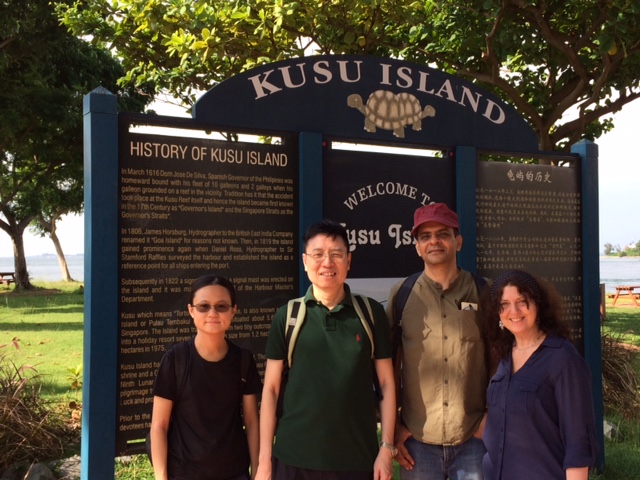Adventures in fiction collaboration

The scene is on one of the Southern Islands in Singapore called Kusu Island.
Objective: To recce the crime scene in a police procedural that we are writing.
Kusu island: We have to take a ferry (or commercial boat) that runs on an hourly basis from the Marina South Pier on the mainland. This island has a popular Chinese temple (often for fertility and good luck) which is busy only a month of the year. On the top of a hill (152 steps), one could find three muslim shrines called the Keeramet. The name of the island means 'turtoise' and there were several legends concerning the name.
Our writing project: Initially we wrote about a murder that took place on this island in a daisy chain manner. This was just a writing exercise but now it had evolved into a police procedural book. It was a matter of chance that we decided the setting to be on this island. Like some of the peripheral islands of Singapore, Kusu is relatively secluded and the members of the public are not permitted to stay overnight. And of course, our party of suspects (all women above seventy years) did exactly that, and we determined that the murder took place in the vicinity of the Keeramet.
A month ago, we started outlining for the book, and made some plans to visit the island in order to be able to write realistically. Unexpectedly, on the same evening that we made these plans, a fire broke out and destroyed the Keeramet. This happened in real life, not in our book. How eerie!
Our visit: We scouted out the places where the murder could have taken place. We considered these factors: the lighting, the presence of shelter, the vicinity from a washroom (always relevant, because the characters in our book are actually a group of women) and privacy. We found out that two people at the Chinese temple and one caretaker normally reside on the island. For the plot of our story to work, the women in our story would have to make some excuse in order to sleep overnight, or evade these island residents. We were not able to visit the Keeramet as after the fire, the renovations to that area would take months.
Our collaboration: Each of us (see photograph taken on Kusu island) are already used to collaborate with others in our separate professional lives. How did we meet? We met in a writing and critique group called Caferati.
Imagine working together in a fiction project! Most fiction writers work alone. They can feel very isolated throughout this writing process, and the pandemic didn't help. There are many advantages to working in a group like this. For one, we set our goals and timelines for everyone, and this helps to keep us focused. Because nobody likes to be the one that delays the entire project. Also, the four writers have different backgrounds and strengths, and our skill and experience complement well.
In a recent webinar, the writer Vi Khi Nao talked about her numerous fiction (including poetry) collaborations. She described how we can approach other writers and how she had published a few works this way. In her case, she had approached writers whom writing style she admired. They would often start on a very small project first, for example, a poem. The process is quite fun. They might set a time to write together on the Google Docs platform, with each writer contributing every other line of the poem. The authors she collaborated with might not even be in the same city or country. Of course, not all collaborations get published. She said only about ten percent of such collaborative works of hers get published.
Let me think what you feel about collaborative writing! Will you try it?
Thank you for commenting!
Have a great day!
